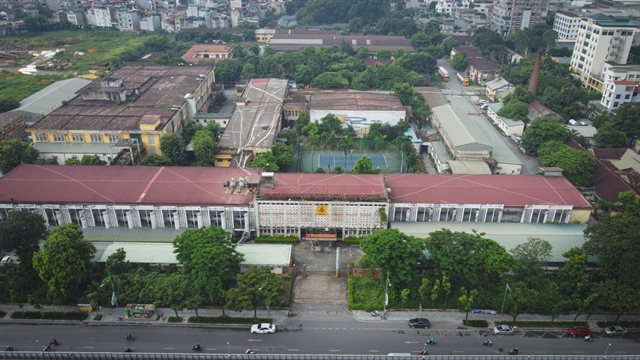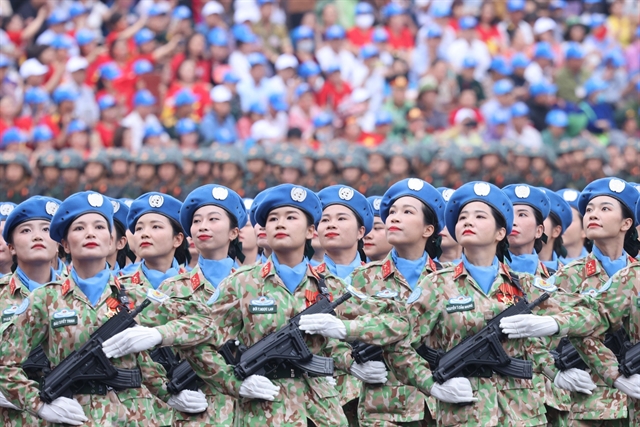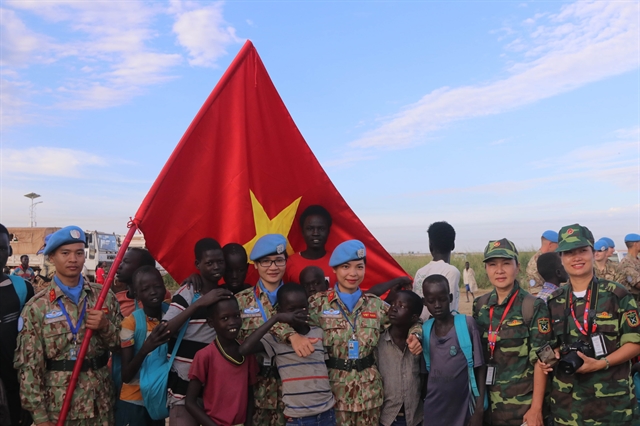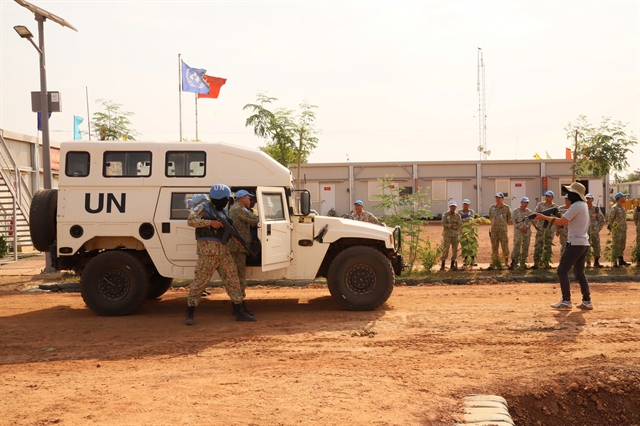 Opinion
Opinion
.jpg)
 |
| Vietnamese female peacekeepers at a military parade in 2024. — VNA/VNS Photo |
HÀ NỘI — In the early 1970s, Việt Nam’s war-scarred image was etched in the world’s memory. Fast forward fifty years, and that same nation is now donning the iconic blue berets of the United Nations - not as victims of conflict, but as builders of peace.
In just over a decade, Việt Nam has emerged as one of Asia’s most active and admired contributors to global peacekeeping operations, redefining its role on the world stage with quiet discipline, strategic foresight, and a deeply human touch.
From Vision to Deployment: The Political Will Behind the Mission
Việt Nam’s entry into UN peacekeeping was no accident. It was a long-term strategy crafted at the highest levels of government. In 2012, the Politburo approved a Master Plan for Participation in UN Peacekeeping, and in 2013, peacekeeping was explicitly named in Resolution 22-NQ/TW on international integration, emphasising the country's intent to participate in "higher-level multilateral institutions."
By May 2014, the Prime Minister had signed off on two critical frameworks - one for the People’s Army and one for the Public Security Forces, establishing Việt Nam’s dual-track approach to peacekeeping: military and police.
Soon after, the Vietnam Peacekeeping Centre (now the Vietnam Department of Peacekeeping Operations) was launched. This marked the beginning of Việt Nam’s institutional preparation not just to contribute troops but to build a sustainable peacekeeping ecosystem.
Boots on the Ground: Where Việt Nam Serves
Vietnamese forces currently serve in three UN missions and at the UN headquarters in New York, with deployments in both individual and unit formats:
• UNMISS (South Sudan): The cradle of Việt Nam's peacekeeping debut. Since 2014, Việt Nam has maintained an uninterrupted presence here, deploying not only staff officers and observers but also rotating Level-2 Field Hospitals staffed by military doctors, surgeons, and logisticians.
• UNISFA (Abyei): In 2022, Việt Nam deployed its first Engineering Unit to this disputed area between Sudan and South Sudan. They built roads, bridges, field bases, and even classrooms for local children.
• MINUSCA (Central African Republic): Việt Nam’s officers serve in staff positions across intelligence, operations, logistics, and communications. Some also act as military observers, conducting real-time security assessments in volatile zones.
• UN Headquarters (New York): Since 2020, Vietnamese officers have held strategic planning roles at the UN’s Department of Peace Operations. Their work influences policy and operations for peacekeeping missions globally.
 |
| Officers from Level-2 Field Hospital Rotation No.1 play with children in South Sudan. — Photo courtesy of Level-2 Field Hospital Rotation No.1 |
The Numbers Behind the Commitment
To date, Việt Nam has deployed nearly 1,100 personnel to UN peacekeeping operations. These include:
• Over 150 military officers deployed as staff officers, military observers, or liaison personnel.
• Six Level-2 Field Hospitals, each staffed with 63 military medics and logisticians.
• Three Engineering Units, each with 184 officers and heavy machinery, including bulldozers, cranes, and road-laying equipment.
• Police forces deployed since 2022, including five teams sent to South Sudan, Abyei, and the UN headquarters.
A sixth police team is set to deploy to MINUSCA in June 2025, marking the first time Việt Nam’s Ministry of Public Security will participate in the MINUSCA mission.
More than Peacekeepers: Community Builders
One of the most distinctive features of Việt Nam’s contribution is its humanitarian ethos. In South Sudan, Vietnamese doctors have performed over 1,300 surgeries and provided routine healthcare to civilians and UN personnel.
In Abyei, engineers noticed schoolchildren studying under thatched roofs. In response, they built a permanent classroom using scrap materials and local labour, a gesture that sparked admiration from both the UN and local leaders.
In the Central African Republic, Lieutenant Colonel Nguyễn Thị Liên, Việt Nam’s first female peacekeeper at MINUSCA, spent her spare time teaching poor villagers to plant vegetables and make nutritious meals, prompting locals to affectionately nickname her 'Madam Liên.'
 |
| Officers from Level-2 Field Hospital Rotation No.6 donate school supplies to children in South Sudan. — Photo courtesy of Level-2 Field Hospital Rotation No.6 |
Leading on Gender Equality
Việt Nam is one of the few nations exceeding UN benchmarks for female participation in peacekeeping: About 16 per cent of individually deployed peacekeepers from Việt Nam are women, higher than the UN average.
Even in the engineering units - traditionally male-dominated - women account for 12 per cent of the force, compared to near-zero in many other countries.
The Ministry of National Defence has committed to maintaining and increasing female participation, targeting a rate of over 20 per cent for individual roles and over 15 per cent for unit-based deployments in the 2025–2030 period.
These efforts underscore Việt Nam’s commitment to UN Security Council Resolution 1325 on Women, Peace, and Security, earning praise from top UN officials and setting a model for other member states.
A Legal Architecture to Support Long-Term Commitment
Việt Nam’s rapid progress was made possible by a comprehensive legal framework:
• In November 2020, the National Assembly passed Resolution 130/2020/QH14, codifying peacekeeping participation.
• In May 2021, Decree No.61 detailed the legal rights and responsibilities of deployed personnel.
• On June 26, 2025, Việt Nam passed Law on Participation in United Nations (UN) Peacekeeping Operations, establishing the fundamental principles, roles, functions, and operational framework for Việt Nam’s engagement in the UN peacekeeping missions. .
This legal architecture not only ensures transparency and accountability but also provides financial, logistical, and welfare support for personnel, particularly encouraging female participation and unit-level deployments.
 |
| Officers from Engineering Unit No.3 conduct a training exercise on handling armed robbery scenarios in Abyei. — Photo courtesy of Engineering Unit No.3 |
International Recognition: A Rising Power in Peacekeeping
Việt Nam’s efforts have not gone unnoticed. In 2018, the UN designated Việt Nam’s Peacekeeping Department as one of only four regional training centres in Asia.
All Vietnamese peacekeepers have received UN Peacekeeping Medals, a rate far above average. Many have earned personal commendations from mission commanders for outstanding service.
UN dignitaries, including Secretary-General António Guterres, Under-Secretary-General for Peace Operations Jean-Pierre Lacroix, and Under-Secretary-General for Operational Support Atul Khare, have all publicly commended Việt Nam. Atul Khare called Việt Nam’s field hospital deployments "a wonderful thing in the partnership between the country and the UN."
At UNMISS, Lieutenant General Mohan Subramanian, Force Commander, lauded Vietnamese peacekeepers for "bringing medical expertise and the values of peace, compassion and the image of a humane, disciplined and trustworthy Việt Nam to the international community."
 |
| Lieutenant General Mohan Subramanian, Force Commander of the UN Mission in South Sudan, presented the UN Medal for Peacekeeping to Vietnamese officials. — Photo courtesy of Level-2 Field Hospital Rotation No.6 |
Looking Ahead: Ready for More
Việt Nam’s peacekeeping ambitions are far from plateauing. In 2025, the country will continue its steady expansion with the deployment of Engineering Unit No.4 and Level-2 Field Hospital Rotation No.7.
Plans are also underway to register new unit types - including mechanised infantry, communications teams, and airport support units - into the UN Peacekeeping Capability Readiness System (PCRS). This would allow Việt Nam to respond more flexibly to evolving UN needs and increase its operational footprint.
Additionally, the country aims to elevate its strategic influence by nominating more personnel to senior leadership positions within UN missions and at UN Headquarters. These efforts signal Việt Nam’s intent not only to contribute manpower but to help shape policy and command decisions.
Việt Nam’s journey from war-torn nation to peacekeeping pillar is one of the most compelling transformations in modern international relations. With its distinctive blend of discipline, diplomacy, compassion, and gender leadership, Việt Nam has carved out a niche as a trusted peacebuilder on the global stage.
As conflicts evolve and the demand for peacekeeping grows, the "blue berets" of Việt Nam are proving that small nations can make a big impact - not just with weapons or wealth, but with will, wisdom, and a deep respect for human dignity. — VNS
.jpg)



